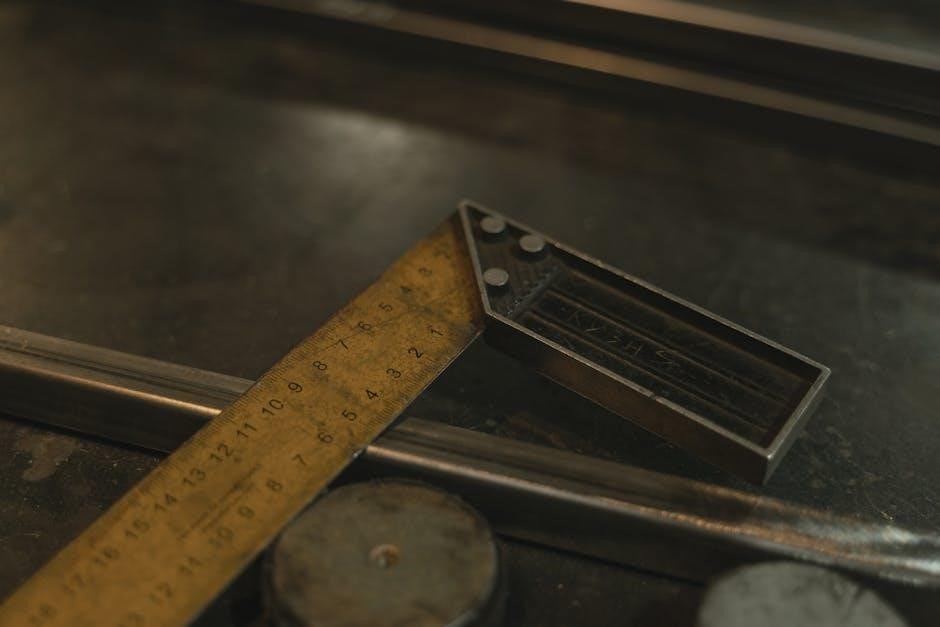
National Pipe Thread (NPT) is a U.S. standard for tapered threads used on pipes and fittings. NPT threads are designed to provide a leak-proof seal for fluid and gas transfer, crucial for plumbing and hydraulic systems.

NPT Thread Overview
Definition and Purpose of NPT Threads
National Pipe Thread (NPT), as defined by ANSI/ASME B1.20.1, is a tapered thread standard crucial for creating mechanically strong, pressure-tight seals in piping and fittings. The taper, standardized at 3/4 inch per foot, ensures that as the male and female threads are tightened, they wedge together, enhancing the seal. These threads are essential in plumbing, hydraulics, and gas systems, preventing leaks and maintaining system integrity through mechanical force and sealant use.

NPT Thread Standards
NPT threads are governed by ANSI/ASME B1.20.1, which specifies dimensions, tolerances, and gauging practices. Adherence to this standard ensures interchangeability and reliable sealing performance in various applications.
ANSI/ASME B1.20.1 Standard
The ANSI/ASME B1.20.1 standard is the bedrock of NPT thread specifications, outlining everything from thread dimensions to acceptable tolerances. This standard defines the requirements for general-purpose pipe threads, ensuring compatibility and reliable sealing. It covers crucial aspects like thread form, pitch, taper, and truncation, providing a comprehensive framework for manufacturing and inspection. Compliance with B1.20.1 guarantees that NPT threads meet the necessary quality and performance criteria for plumbing, hydraulics, and gas fitting applications, promoting safety and preventing leaks.
Key to NPT threads is their taper, standardized at 1/16 (3/4 inch per foot). This taper ensures that as the threads are tightened, they create increasing friction and compression, forming a tight, leak-resistant seal.
Taper Rate
The taper rate of NPT threads is a critical dimension, set at 1 in 16, which equates to 3/4 of an inch per foot. This taper means that the diameter changes by 0.0625 inches for every inch of thread length. This standardized taper allows for a mechanical seal to form as the male and female threads are tightened. The angle created by this taper ensures increasing compression, essential for leak-free connections in fluid and gas systems.

NPT Thread Dimensions
Key Dimensional Parameters (Diameter, Threads per Inch)
Key parameters for NPT threads include both diameter and threads per inch (TPI). The nominal pipe size dictates the outer diameter of the pipe and the corresponding TPI. For example, a 3/4 NPT thread has an outside diameter around 1.050 inches with 14 TPI. These dimensions are standardized to ensure compatibility and proper sealing when connecting pipes and fittings. Referencing an NPT thread chart is crucial for accurately determining these dimensions for various pipe sizes.
Tapered Pipe Thread (NPT)
The tapered pipe thread (NPT) is designed with a conical shape to create a tight seal. Both internal and external threads have this taper, requiring sealant for a pressure-tight connection in various applications.
Tapered Pipe Thread (NPT)
Tapered Pipe Thread (NPT) is a standard where both male and female threads are tapered. This design, coupled with a sealant, ensures a leak-proof seal. The taper rate is 1/16 (3/4 inch per foot), meaning the diameter changes by 1/16 inch per inch of length. Commonly used in plumbing, hydraulic, and gas systems, NPT threads require wrenching to achieve a tight joint. Proper engagement is crucial for effective sealing and preventing leaks in fluid and gas applications.
Internal Straight Thread (NPSC)
Internal Straight Pipe Thread (NPSC) features straight threads designed to mate with tapered NPT threads. Unlike NPT, NPSC threads do not create a seal on their own and require a gasket or O-ring for a leak-proof connection. Typically used in low-pressure applications or where frequent assembly and disassembly are needed, NPSC threads offer ease of use. They are often found in fittings where a mechanical seal is preferred over a thread sealant.

NPT Thread Types
Railing Joint Taper Thread (NPTR)
Railing Joint Taper Thread (NPTR) is specifically designed for railing joints. NPTR threads are tapered, similar to NPT threads, but are engineered to provide mechanical strength and alignment in railing systems. These threads are not intended to create a pressure-tight seal like standard NPT threads. Instead, NPTR threads ensure structural integrity and proper fit for railings and related components. Sealants are generally not used with NPTR threads, focusing instead on the mechanical bond.
NPT vs. NPTF (Fine)
NPT and NPTF threads both are tapered, but NPTF (Dryseal) is designed for a tighter seal without sealant. NPT typically requires sealant for leak-proof joints, while NPTF aims for a metal-to-metal seal.
NPT vs. NPTF (Fine)
NPT (National Pipe Thread) and NPTF (National Pipe Taper Fuel) are both tapered pipe threads, but differ in their sealing mechanisms. NPT threads generally require a sealant to achieve a leak-proof connection, whereas NPTF threads, also known as Dryseal threads, are designed to create a tighter mechanical seal without the need for sealant. This is achieved through controlled truncation, ensuring the crests crush against the roots during assembly, creating a more reliable seal, especially in fuel and hydraulic applications.

NPT vs. Other Thread Types
NPT vs. NPS (Straight)
NPT (National Pipe Thread) and NPS (National Pipe Straight) threads are distinct types of pipe threads, differing in their taper. NPT threads are tapered, which aids in creating a tight seal as they are tightened. NPS threads, on the other hand, are straight and require a gasket or O-ring to create a seal. NPT threads are typically used for connections where a pressure-tight seal is necessary, while NPS threads are often used for mechanical joints.
NPT threads are widely used in plumbing applications for connecting pipes and fittings. Their tapered design ensures a tight, leak-free seal, essential for water and other fluid transport within residential and commercial plumbing systems.
Plumbing
Within plumbing systems, NPT threads are critical for creating secure and reliable connections between pipes, valves, and fittings. The tapered design, when properly sealed with Teflon tape or pipe dope, ensures a leak-resistant joint. Common plumbing applications include water supply lines, drainage systems, and connections to fixtures like faucets and showerheads. The NPT standard ensures compatibility and reliable sealing in diverse plumbing installations across residential, commercial, and industrial settings, preventing costly leaks and water damage.
Hydraulic Systems
NPT threads play a vital role in hydraulic systems, facilitating the secure transmission of fluids under high pressure. These threads are commonly used in hydraulic fittings, hoses, and connections to pumps and cylinders. The tapered design ensures a tight, leak-free seal, essential for maintaining system pressure and preventing fluid loss. Proper application of sealant is crucial to enhance the sealing capabilities of NPT threads in these demanding hydraulic environments, ensuring efficient and safe operation.

NPT Applications
Gas Fittings
NPT threads are extensively used in gas fittings to create secure and leak-proof connections in gas lines and appliances. Their tapered design ensures a tight seal, preventing gas leaks that could pose safety hazards. Commonly found in natural gas and propane systems, NPT fittings connect pipes, valves, and regulators. The application of a suitable thread sealant is crucial in gas fittings to ensure a reliable and safe connection, preventing any potential gas leakage and maintaining system integrity.
The NPT size chart provides critical dimensions for selecting the correct NPT thread size. It includes data on outer diameter and threads per inch, essential for ensuring proper fitting and sealing.

NPT Size Chart
Using the NPT Size Chart
To effectively use the NPT size chart, identify the nominal pipe size needed for your application. Locate this size on the chart and note the corresponding outer diameter and threads per inch (TPI). These dimensions are crucial for ensuring compatibility between pipes and fittings. Verify that the measured dimensions of your components match the chart’s specifications for a secure, leak-free connection. Remember that correct size selection is paramount for optimal system performance and safety in plumbing, hydraulic, and gas systems.
NPT threads can be cut using manual or machine methods. Manual cutting involves pipe threading tools, while machine cutting uses lathes or threading machines. Accuracy and proper lubrication are essential for quality threads.
Methods for Cutting NPT Threads
Cutting NPT threads requires precision to achieve the correct taper and thread dimensions specified in the ANSI B1.20.1 standard. Manual methods use pipe threaders, while powered machines like lathes offer greater control. Proper lubrication is crucial to reduce friction and ensure clean cuts. The angle of the cutting tool must match the NPT taper. Accurate measurement and frequent checks are essential for achieving a leak-proof seal.

Cutting and Identifying NPT Threads
Identifying NPT Threads
Identifying NPT threads involves checking several key features, starting with the thread’s tapered shape, approximately 3/4 inch per foot. The number of threads per inch must match the NPT standard for the pipe size. Use an NPT thread gauge to accurately measure the thread pitch diameter. Markings on the pipe or fitting often indicate the NPT size. Comparing the thread dimensions to an NPT thread chart is essential for verification.

Sealing NPT Threads
NPT threads rely on sealant to create pressure-tight joints. The taper ensures mechanical grip, while sealant fills gaps, preventing leaks in plumbing, hydraulic, and gas systems using appropriate thread sealants.
The Role of Sealant in NPT Connections
Due to the inherent design of NPT threads, achieving a leak-free seal requires the use of a thread sealant. The tapered nature of the threads creates a mechanical interference fit when tightened, but microscopic gaps remain between the thread peaks and valleys. Sealants fill these imperfections, creating a barrier against fluid or gas leakage. Proper application of sealant is crucial for ensuring a reliable and pressure-resistant connection in NPT systems, particularly in plumbing, hydraulics, and gas fitting applications where a secure seal is paramount.

